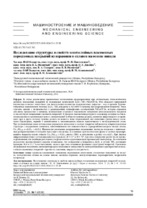| dc.contributor.author | Пантелеенко, Ф. И. | |
| dc.contributor.author | Оковитый, В. А. | |
| dc.contributor.author | Девойно, О. Г. | |
| dc.contributor.author | Сидоров, В. А. | |
| dc.contributor.author | Оковитый, В. В. | |
| dc.contributor.author | Асташинский, В. М. | |
| dc.contributor.author | Блюменштейн, В. М. | |
| dc.coverage.spatial | Минск | ru |
| dc.date.accessioned | 2024-02-05T13:29:11Z | |
| dc.date.available | 2024-02-05T13:29:11Z | |
| dc.date.issued | 2024 | |
| dc.identifier.citation | Исследование структуры и свойств многослойных плазменных порошковых покрытий из керамики и сплавов на основе никеля = Study of the Structure and Properties of Multilayer Plasma Powder Coatings of Ceramics and Nickel-Based Alloys / Ф. И. Пантелеенко [и др.] // Наука и техника. – 2024. – № 1. – С. 15-20. | ru |
| dc.identifier.uri | https://rep.bntu.by/handle/data/140897 | |
| dc.description.abstract | В статье рассмотрены проведенные исследования сформированных при оптимальных технологических режимах плазменных покрытий из порошковых композиций Al2O3–TiO2–NiCrAlYТа. Они обладают приемлемой плотностью и имеют допустимое для эксплуатации количество поверхностных дефектов – пор и трещин. Крупногабаритные керамические частицы Al2O3–TiO2 внедрены в NiCrAlYТа матрицу при формировании покрытия. Такое строение связано с подвижностью у расплавленных жидкофазных составляющих NiCrAlYТа, которые стремятся заполнить промежутки и трещины, возникающие в процессе плазменного напылении металлооксидного покрытия и способствуют повышению плотности покрытий. В процессе высокотемпературного осаждения оксидная составляющая плавится в органическое целое с металлической в области границы раздела, элементы диффундируют и проникают друг в друга, поэтому граница раздела не является четко определенной, нет очевидных границ между слоистыми структурами, наравне с химическими и механическими связями присутствуют и металлургические связи. При установленных нами оптимальных параметрах напыления в системе покрытия наблюдается микрогетерогенная структура с содержанием элементов, обеспечивающих его износостойкость (орторомбическая фаза оксида титана, Cr1,12Ni2,88, альфа-Al2O3, γ-Al2O3). Происходит растекание расплавленных порошковых частиц на подложке с минимальным разбрызгиванием и потерями при ударе о подложку. К основным кристаллическим фазам в системе сформиро- ванного покрытия можно отнести Cr1,12Ni2,88, γ-Al2O3, анатаз (TiO2) в дополнение к рутилу и альфа-Al2O3. При анализе дифракционные пики у рутила выявляются в пределах 2θ = 32° и 2θ = 70°, при этом содержание растет после процесса распыления, что подтверждает переход из фазы анатаза в рутильную фазу при высокой температуре. На основании результатов количественного анализа установлено, что содержание в покрытии альфа-Al2O3 и рутила TiO2 составляет примерно 30,4 и 32,2 % соответственно, являясь при этом основными фазовыми структурами покрытий. Проведены исследования по влиянию дистанций процесса плазменного напыления на эксплуатационные характеристики износостойких плазменных покрытий – прочность сцепления, твердость и пористость. | ru |
| dc.language.iso | ru | ru |
| dc.publisher | БНТУ | ru |
| dc.title | Исследование структуры и свойств многослойных плазменных порошковых покрытий из керамики и сплавов на основе никеля | ru |
| dc.title.alternative | Study of the Structure and Properties of Multilayer Plasma Powder Coatings of Ceramics and Nickel-Based Alloys | ru |
| dc.type | Article | ru |
| dc.identifier.doi | 10.21122/2227-1031-2024-23-1-15-20 | |
| local.description.annotation | The paper deals with the studies of plasma coatings formed under optimal technological conditions from Al2O3–TiO2–NiCrAlYТа powder compositions. They have an acceptable density and have a number of surface defects acceptable for operation – pores and cracks. Large-dimensional ceramic Al2O3–TiO2 particles are embedded in the NiCrAlYТа matrix during the formation of the coating. This structure is associated with the mobility of the molten liquidphase components of NiCrAlYТа, which tend to fill gaps and cracks that occur during plasma spraying of metal oxide coating and contribute to an increase in the density of coatings. In the process of high-temperature deposition, the oxide component melts into an organic whole with a metal one in the area of the interface, the elements diffuse and penetrate each other, so the interface is not clearly defined, there are no obvious boundaries between layered structures. These structures, along with chemical and mechanical bonds, also contain metallurgical bonds. With the optimal spraying parameters we have established, a microheterogeneous structure is observed in the coating system with the content of elements that ensure its wear resistance (orthorhombic phase of titanium oxide, Cr1.12Ni2.88, alpha-Al2O3, γ-Al2O3). Spreading of molten powder particles on the substrate occurs with minimal spattering and losses upon impact on the substrate. The main crystalline phases in the system of the formed coating include Cr1.12Ni2.88, γ-Al2O3, anatase (TiO2) in addition to rutile, and alpha-Al2O3. In the analysis, diffraction peaks in rutile are detected in the ranges 2θ = 32° and 2θ = 70°, while the content increases after the sputtering process, which confirms the transition from the anatase phase to the rutile phase at high temperature. Based on the results of quantitative analysis, the content in coating of alpha-Al2O3 and rutile TiO2 is approximately 30.4 % and 32.2 %, respectively, being the main phase structures of the coatings. Studies have been carried out on the influence of distances of the plasma spraying process on the performance characteristics of wear-resistant plasma coatings – adhesion strength, hardness and porosity. | ru |

